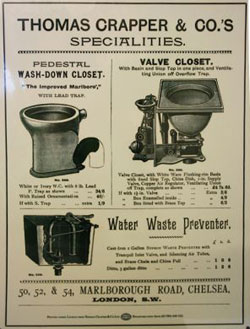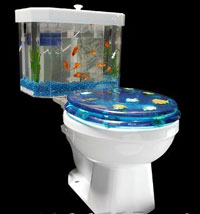 Toilets – The flushing toilet was invented by Sir John Harrington in 1596 for Queen Elizabeth I. Thomas Crapper was a plumber who founded Thomas Crapper & Co. in London. Contrary to widespread misconceptions, Crapper did not invent the water closet. Thomas Crapper perfected the siphon flush system we use today.
Toilets – The flushing toilet was invented by Sir John Harrington in 1596 for Queen Elizabeth I. Thomas Crapper was a plumber who founded Thomas Crapper & Co. in London. Contrary to widespread misconceptions, Crapper did not invent the water closet. Thomas Crapper perfected the siphon flush system we use today.
Some other terms for the toilet include: washroom, outhouse, powder room, ladies, lavatory, potty, women’s room, bog, necessary, dunny, bathroom, gents, men’s room, khazi, convenience, garderobe, restroom, place of easement, privy, john, potty, water closet, the smallest room, can, little girls’ or boys’ room, facilities, and throne room.
November 19 is world Toilet Day. Bet you can learn a lot of fun toilet facts on Toilet Day.
The average person spends three whole years of their life sitting on the toilet. That is 2500 times per year or about 6-8 times a day.
The first toilet cubicle in a row is the least used (and consequently cleanest). IMPORTANT FACT
The Roman army didn’t have toilet paper so they used a water soaked sponge on the end of a stick instead!
The toilet is flushed more times during the super bowl halftime than at any time during the year.
90% of pharmaceuticals taken by people are excreted through urination. Therefore our sewer systems contain heavy doses of drugs. A recent study by the EPA has found fish containing trace amounts of estrogen, cholesterol-lowering drugs, pain relievers, antibiotics, caffeine and even anti-depressants.
Lack of suitable toilets and sanitation kills approximately 1.8 million people a year, many of them children.
The toilet handle in a public restroom can have up to 40,000 germs per square inch.
Every year, there are more than 40,000 toilet-related injuries in the US. The odds are 1 out of 10000 that you will get a toilet-related injury this year.
You’re probably wondering how astronauts relieve themselves in outer space. Space shuttles do not have bathrooms the way airplanes do. Air pressure is key in determining where toilet wastes go. Waste is usually disposed of outside of the shuttle and out into space. Astronauts do not shower. They cleanse themselves using wash cloths.
In 1890, Scott Paper Company produced toilet paper in rolls –the one you are accustomed to using today- for the first time.
The most luxurious toilet in the world was made of pure gold. This 24 carat gold toilet existed in the Hall of Gold in Honk Kong. It was owned by the Hang Fung jewelers who had the toilet built as a marketing strategy to attract tourists from around the world. Unfortunately, the toilet might not be around for long due to changes in the Hang Fung jewelers’ operations. They have decided to melt the golden toilet in order to finance their expansion to Mainland China.
The average life expectancy of a toilet is 50 years.
Pomegranates with studs of clovers were used as the first toilet air-fresheners
Falling off a toilet is the cause of death of King George II of Great Britain.
The White House has thirty bathrooms. The Pentagon uses about 636 toilet paper rolls per day.
The toilet is the home appliance that uses up the most amount of water
Alfred Hitchcock’s film “Psycho” was the first movie to include a scene showing a toilet being flushed. The scene garnered complaints of indecency.
People use about 57 sheets of toilet paper everyday.
The first World Summit on Toilets was conducted in Singapore in 2001.
Over $100,000 US dollars was spent to finance a study on determining whether people put their toilet rolls on the holder with its flap in front or behind. The result: 3 out of 4 individuals will have the flap in front.
The first toilet paper was produced in England in 1880 but was not sold in rolls. Instead, it came in boxes with individual sheets. Bet they didn’t need too many advertising slogans to sell this must have product.
Most toilets will flush in the key of E flat. The first time male and female toilets were separated was in Paris during a high-class party in 1739.
The first time male and female toilets were separated was in Paris during a high-class party in 1739.
The most expensive toilet in the galaxy is found in space. Each toilet in space costs about 19 million dollars.
A rat can survive after being flushed down in a toilet. It can return through the same route.
Hermann Goering refused to use regulation toilet paper – instead he bought soft white handkerchiefs in bulk and used them
